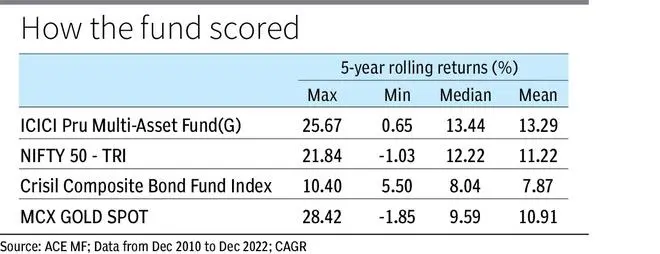In any market condition, asset allocation becomes important for attaining optimal portfolio returns and reaching financial goals based on your individual risk appetite. This aspect becomes even more significant in the current circumstances as indices touch new highs. The equity portion tends to become bloated in investor portfolios during such times, exposing holdings to drawdowns during any subsequent corrections.
Multi-asset funds, which invest in a blend of equity, debt and gold, may be suitable for investors with a modest risk appetite and even for those just beginning their market journey given the volatility in the indices and macroeconomic indicators.
In this regard, ICICI Prudential Multi-Asset Fund may be a good choice for investors of all hues, given its consistent show over the years. Among the schemes in the multi-asset hybrid category, the fund has the best record across timeframes.
Multi-asset strategy
Equity, debt and gold have very little correlation to each other’s moves across timelines. When mapped over 10-20 year periods, equity-debt, gold-debt and equity-gold have negative or very low correlation coefficients. Thus, a diversified portfolio with all three asset classes in appropriate ratios based on individual risk appetites would tend to lower risks and give a smoother ride towards goals.
That’s where a multi-asset fund can help. The fund manager decides on the allocation to equity, debt and gold based on market conditions and therefore such schemes make it easier for investors, especially new ones, to enter the market irrespective of index levels. Of course, a fund manager’s ability to make smart calls across at least three asset classes would be critical in the success of the fund.
Here are some pointers to how asset classes have moved over the years.
- In CY2008, amidst the global financial crisis, the Sensex fell 52.4 per cent. In the same year, gold (MCX prices) delivered 26.1 per cent returns, while debt (CRISIL Short Term Bond Index) gave 9.5 per cent. In 2011, Sensex fell 24.6 per cent, while gold prices rallied 31.7 per cent. In 2020, when the pandemic raged, gold delivered 28 per cent returns, while the Sensex gave just 15.8 per cent. Short point: the returns of asset classes follows varying trajectories.
- Equity in general is the key, and large, component of any portfolio for long-term goals, as it drives returns. Gold is considered a hedge against inflation. But it has actually delivered much more than inflation over the long term. The problem for investors however is that it can have many years of strong returns (23.2-31.7 per cent returns each calendar year from 2008 to 2011) and long periods of falls (4-8 per cent declines each year from 2013 to 2015).
- Over five-year rolling periods from March 2007 to October 2022, the CRISIL Composite Bond Fund Index has given 7.3 per cent average returns annually. Debt is thus a stabilising factor in portfolios.
- When the equity component in the multi-asset fund is 65 per cent or more on an average, you get equity taxation benefits.
Why ICICI Multi-Asset Fund?
It has generally been the best fund in the category, ahead of peers such as HDFC Multi-Asset, Axis Triple Advantage and SBI Multi Asset Allocation. Quant Multi Asset has been closing the gap in performance in recent years, but still ICICI Multi-Asset scores the best.
The fund takes prompt valuation and interest rate calls to shuffle asset allocation. It has been able to do well on this aspect over the years. From a peak of 78 per cent equity allocation in March 2021, the fund has trimmed exposure to 56 per cent (net of derivative exposures) as of October 2022. Gold and Silver (mild exposure) account for around 14 per cent. Debt and cash account for over 29 per cent of the portfolio.
The fund goes into cash position to the tune of 15 per cent during highly corrective markets, which helps prevent downsides. ICICI Prudential Multi-Asset has managed to take rewarding contrarian calls such as with metal & mining, oil & gas in 2021, pharma in 2020, power in 2016 and so on.
In recent times, it has pared exposure to sectors such as software, consumer non-durables, retail and banking. The fund has increased weightage to power, telecom, auto and pharma as valuations turn attractive in these segments.
Overall, investors with five-plus years of investment timeline can consider the fund for steady returns. Exposure can also be taken via the SIP route for the long term.









Comments
Comments have to be in English, and in full sentences. They cannot be abusive or personal. Please abide by our community guidelines for posting your comments.
We have migrated to a new commenting platform. If you are already a registered user of TheHindu Businessline and logged in, you may continue to engage with our articles. If you do not have an account please register and login to post comments. Users can access their older comments by logging into their accounts on Vuukle.